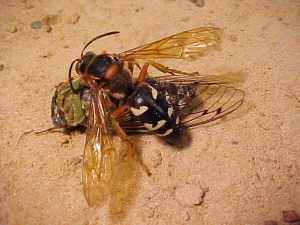
http://bexar-tx.tamu.edu/homehort/archives-of-weekly-articles-davids-plant-of-the-week/giant-wasps-infesting-local-lawns/cic-vs-cic-killer-wasp/
Texas A&M AgriLife Extension – Paper Wasps, Yellowjackets, and Solitary Wasps
Identification
Cicada killers are one of the largest wasps in the United States, reaching a size of approximately 1.5 inches in length. They are considered beneficial insects since they prey on adult cicadas. People usually encounter the male cicada killer, which is stinger-less and therefore harmless. The females rarely sting and will only do so if handled.
Biology
A single reproductive female will dig a nest in sandy soils and will burrow 0.3 to 1.2 meters into the ground, sometimes creating multiple branchings and cells that extend off from the main tunnel. When a female wasp has caught a cicada, she will paralyze it and carry it back to her nest. The cicada will be deposited into a cell and an egg will be deposited on it. A brood cell can have multiple cicadas and the egg will always be laid on the last cicada placed in the cell. The nest is typically left open while the female is foraging, but each cell is closed once an egg has been laid.

